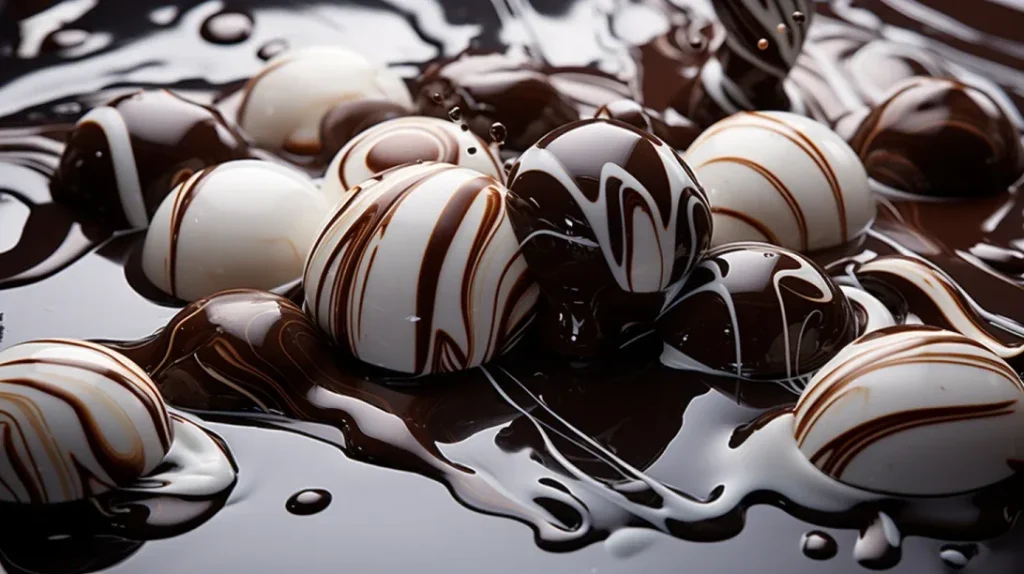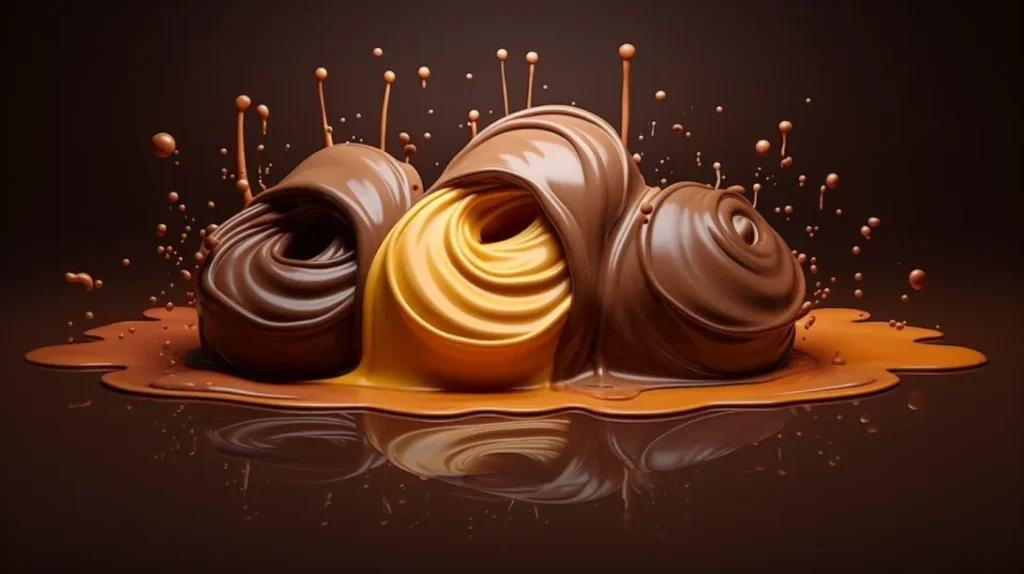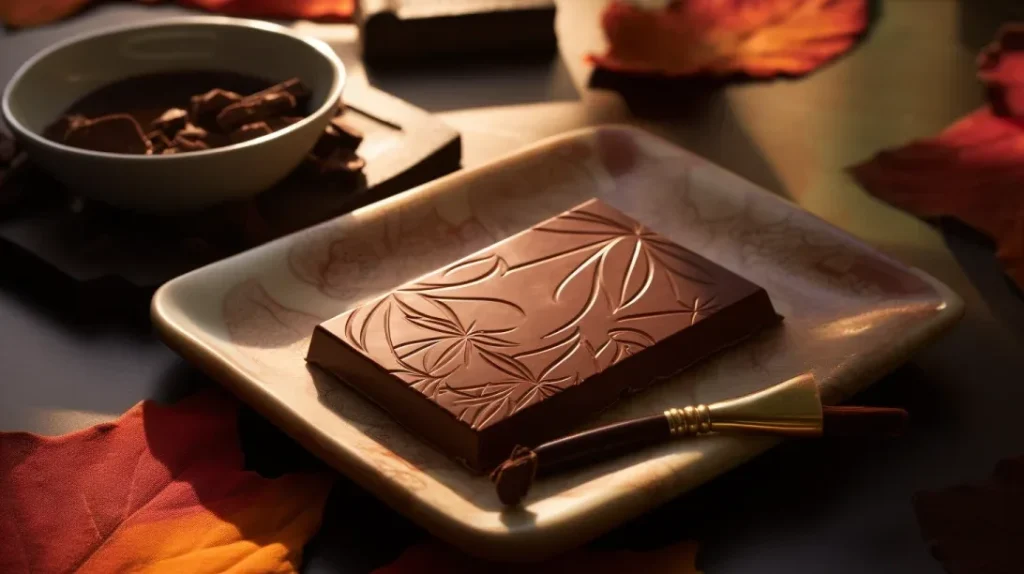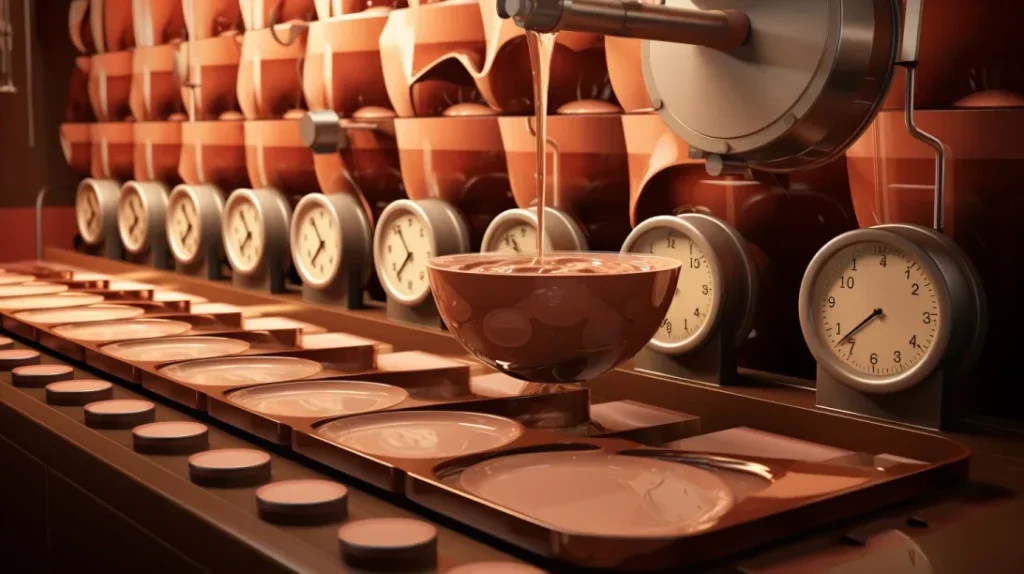Table of Contents
Do you want to save time and money on the wrong chocolate for your baking needs? Look no further!
This article will take you on a chocolatey journey to determine which chocolate melts fastest. Prepare to uncover the truth about dark, milk, and white chocolate melting times.
Discover the impact of melting quality on your pastries, confections, and baked goods. Get ready for a delectable experience as we unravel the mysteries of chocolate melting!
Key Takeaways
- Milk and white chocolate melt faster than dark chocolate due to their lower melting point.
- The essential factor in chocolate melting is not how fast it melts but how well it melts for pastry, confectionery, and baked products.
- High-quality chocolate with high fluidity is ideal for easy application and tempering.
- Embassy Chocolate offers a range of high-performing chocolates, including their bean-to-bar product, Embassy Davao, 67% Single Origin Chocolate.
What is the purpose of this experiment?
This experiment aims to determine which type of chocolate melts the fastest. By measuring the melting time of different chocolates, we can gather valuable information about their physical properties, such as melting temperature, cocoa butter content, and fat content. This data can be helpful for chocolate manufacturers, food scientists, and the chocolate industry as a whole. The experiment can also provide insights into the rheological properties of different chocolate types and aid in developing new cocoa products.
Additionally, the findings interest individuals concerned about health and cognitive function, as certain types of chocolate have been linked to potential benefits. Overall, this experiment explores the melting characteristics of various chocolates and their economic and human health implications.
Types of Chocolate

There are three main types of chocolate: milk chocolate, dark chocolate, and white chocolate. Each type has its unique properties and characteristics.
- Milk chocolate is made by adding milk or condensed milk to cocoa solids. Its sweet and creamy flavor makes it a popular choice for confectionary treats and desserts.
- Dark chocolate contains a higher percentage of cocoa solids and less sugar compared to milk chocolate. It has a rich and intense flavor, often with notes of bitterness. Dark chocolate is also known for its potential health benefits due to its higher cocoa content.
- White chocolate is made from cocoa butter, sugar, and milk solids. It does not contain any cocoa solids and, therefore, lacks the characteristic chocolate flavor. White chocolate has a smooth and buttery texture.
- Chocolate coins are a delightful and popular treat. However, the world of chocolate extends far beyond these sweet confections. Chocolate comes in various forms, from chocolate hearts to chocolate rabbits. The economics of chocolate production and consumption play a significant role in the global market. Researchers in fields such as Food Science, Food Chemistry, and Food Supply are continually exploring the properties of chocolate and its potential health benefits.
- The antioxidant properties of chocolate, influenced by factors like polyphenol and flavonoid content, have garnered attention for their potential health benefits. Additionally, the ratio of sugar to corn syrup and other ingredients in chocolate can affect its taste and nutritional qualities. With the involvement of government food safety standards and organizations like the Food and Drug Administration, consumers can enjoy chocolate with confidence, knowing it meets quality and safety requirements. Overall, the diverse world of chocolate is a sweet subject of study and enjoyment.
- The melting point of chocolate depends on various factors, such as the cocoa butter content and additional ingredients like milk fat. Generally, chocolate melts around body temperature, quickly melting in your mouth.
- Different types of chocolate are used for various applications, such as making chocolate bars, hot chocolate, chocolate chips, or as an ingredient in baking. The choice of chocolate depends on personal preference and the desired flavor and texture in a recipe.
Understanding the different types of chocolate is essential for both chocolate enthusiasts and professionals in the food industry.
Melting Points of Chocolate

To continue our exploration of chocolate melting times, let’s delve into the melting points of different types of chocolate.
- The melting point of chocolate refers to the temperature at which it transitions from a solid to a liquid state. The primary component responsible for the melting point of chocolate is cocoa butter, a fat derived from cocoa beans.
- Despite its lower cocoa content, milk chocolate has a lower melting point than dark chocolate due to the additional dairy ingredients. White chocolate, which contains cocoa butter but no cocoa solids, also has a lower melting point.
Understanding the melting points of different types of chocolate is essential for various applications, such as pastry, confectionery, and baked products, where the quality and fluidity of melted chocolate play a crucial role.
Importance of Melting Quality

Now, let’s delve into the importance of melting quality in chocolate.
- The efficiency of melting factors can significantly impact the final product, especially for pastry, confectionery, and baked goods.
- High-quality chocolate with excellent fluidity is essential for easy application and tempering, ensuring a smooth and professional finish.
- Embassy Chocolate products are designed to offer exceptional fluidity, allowing for versatile applications in various culinary creations.
Melting Efficiency Factors
The quality of its melting characteristics influences the melting efficiency of chocolate. When conducting melting time trials, it’s essential to consider the factors that can affect the speed at which chocolate melts. Here are three key factors that can impact chocolate melting rates:
- Cocoa Content: Dark chocolate with a higher cocoa content tends to have a slower melting rate than milk and white chocolate. This is because the additional cocoa solids in dark chocolate contribute to a thicker consistency.
- Fat Content: Chocolate with a higher fat content, such as couverture chocolate, melts more efficiently and smoothly. The fat acts as a lubricant, allowing the chocolate to flow more freely during the melting process.
- Emulsifiers: The presence of emulsifiers, such as lecithin, can enhance the melting efficiency of chocolate. Emulsifiers help to stabilize the cocoa butter and prevent it from separating, resulting in a smoother, more consistent melt.
Understanding these factors is crucial for achieving high-quality melting results. The following section will explore the impact of melting efficiency on chocolate products.
Impact on Chocolate Products
When considering the impact of melting efficiency on chocolate products, it is crucial to prioritize the quality of the melting characteristics. The melting time, chocolate melting, and melting speed directly affect the overall quality of chocolate products, especially in pastry, confectionery, and baked goods. A high-quality chocolate with a fast and even melting rate ensures easy application and tempering, resulting in a smooth and glossy texture. To illustrate the importance of melting quality, the following table compares the melting time of different types of chocolate:
| Chocolate Type | Melting Time (minutes:seconds) |
|---|---|
| Milk Chocolate | 4:45 |
| Dark Chocolate | 5:00 |
| Cookies and Cream | 5:15 |
As seen in the table, milk chocolate melts the fastest, followed closely by dark chocolate, cookies, and cream. This data emphasizes the significance of melting efficiency in chocolate products and the need for high-quality chocolates with optimal melting characteristics.
Embassy Single Origin Bean-to-Bar Chocolate

Embassy Chocolate proudly presents their first bean-to-bar chocolate product, the Embassy Davao 67% Single Origin Chocolate. This exquisite chocolate offers a unique flavor profile that showcases the richness and complexity of Davao cocoa beans. As a single-origin chocolate, it’s made from scratch using carefully selected cocoa beans, ensuring high quality and craftsmanship.
Here are three key points to note about Embassy Single Origin Bean-to-Bar Chocolate:
- White chocolate option: Embassy Chocolate also offers a high-quality white chocolate option, Embassy Zen White Chocolate 33%. Made from cocoa butter, milk powder, and sugar, this white chocolate is creamy and smooth.
- Melting rate: The melting rate of Embassy Single Origin Bean-to-Bar Chocolate depends on the cocoa content. With a 67% cocoa content, the Embassy Davao chocolate may have a slower melting rate than chocolates with lower cocoa content.
- Unique flavors: Embassy Chocolate takes pride in carefully blending cocoa beans to create unique flavors in their bean-to-bar chocolates. This ensures that each chocolate bar offers a distinctive taste experience.
Embassy Single Origin Bean-to-Bar Chocolate is a testament to the excellence and dedication of Embassy Chocolate in creating premium chocolate products.
Embassy Chocolate High Tea Experience in Singapore

During the Embassy Single Origin Bean-to-Bar Chocolate discussion, you learned about the excellence and craftsmanship behind Embassy Chocolate’s premium products. Let’s delve into the Embassy Chocolate High Tea Experience in Singapore.
This event offers a delightful and diverse chocolate experience. As part of the experience, Embassy Chocolate conducted melting time trials to determine the melting points of different chocolates. The melting point of chocolate is influenced by factors such as cocoa content and temperature.
Through these trials, Embassy Chocolate showcased the melting characteristics of their milk, dark, cookies, and cream chocolate. The results provided valuable insights into the performance of their chocolates and highlighted the importance of quality and craftsmanship in achieving optimal melting properties.
Experiment Setup and Procedure: Materials and Methods

We conducted a series of time trials to determine which type of chocolate melts the fastest. We chose three types of chocolate: milk chocolate, dark chocolate, and white chocolate. Each type was carefully measured and weighed to ensure consistency.
Our experiment used small pieces of chocolate, similar to what you might find in a chocolate bar or chocolate chip cookies. We kept the size and shape of the chocolate pieces consistent to eliminate any variables that could affect the melting time.
To simulate the effects of body temperature, we placed the chocolate pieces on a plate and allowed them to come to room temperature. We then used a digital thermometer to measure the temperature of the chocolate at the start of each trial.
Next, we set up a double boiler system to melt the chocolate. This involved placing a pot of hot water on the stove and a heat-resistant bowl containing the chocolate pieces on top. We stirred the chocolate continuously to ensure even melting.
As the chocolate melted, we monitored the temperature using the thermometer. We recorded the time it took for each type of chocolate to melt into a smooth and liquid consistency completely.
We repeated the time trials multiple times and averaged the results to ensure accuracy. This helped to account for any variations or outliers.
Finally, we analyzed the data and determined which type of chocolate melted the fastest. The results provided valuable insights into the melting properties of every kind of chocolate and could be used by food scientists and manufacturers to optimize their production processes.
This research contributes to our understanding of the physical properties of chocolate and could have implications for various industries, such as the chocolate industry, baking, and confectionery production.
List of materials needed
We gathered a list of materials needed to conduct our melting time trials. We used small pieces of milk chocolate, dark chocolate, and white chocolate, similar to what you might find in a chocolate bar or chocolate chip cookies. To ensure consistency in size and shape, we aimed to eliminate any variables that could affect the melting time.
To simulate body temperature, we placed the chocolate pieces on a plate and allowed them to reach room temperature. Using a digital thermometer, we measured the starting temperature of each chocolate type at the beginning of each trial.
For melting the chocolate, we employed a double boiler system. This involved placing a pot of hot water on the stove and a heat-resistant bowl containing the chocolate pieces on top. We continuously stirred the chocolate to ensure it even melted.
Monitoring the temperature of the chocolate as it melted, we recorded the time it took for each type to liquefy into a smooth consistency. To ensure accuracy, we repeated the trials multiple times and calculated the average results to account for variations or outliers.
We analyzed the data and determined which type of chocolate melted the fastest. These results offer valuable insights for food scientists and manufacturers, assisting in optimizing their production processes.
Step-by-step instructions for the experiment
1. Start by gathering the different types of chocolates you want to test, such as milk chocolate, dark chocolate, and white chocolate.
2. Place a plate in a room and let the chocolates reach room temperature.
3. Begin the experiment by measuring the starting temperature of each chocolate using a digital thermometer.
4. Set up a double boiler system by filling a pot with hot water and placing it on the stove. Place a heat-resistant bowl containing the chocolate pieces on top of the pool.
5. Continuously stir the chocolate as it melts to ensure even heating and prevent burning.
6. Monitor the temperature of the chocolate as it melts using the digital thermometer. Record the time each type of chocolate takes to liquefy into a smooth consistency completely.
7. To ensure accuracy, repeat the melting process multiple times for each type of chocolate and calculate the average time taken.
Following these step-by-step instructions, you can conduct a melting time trial to determine which type of chocolate melts the fastest.
Results: Which Chocolate Melts Fastest
After conducting the melting time trials, we found that the type of chocolate significantly affected the melting time. Dark chocolate demonstrated the fastest melting time, followed by milk and white chocolate.
Dark chocolate, containing a higher percentage of cocoa solids and less milk fat, has a lower melting temperature than other chocolate types. This allows it to melt more quickly when exposed to heat. Milk chocolate, containing more milk fat and sugar, melted slower than dark chocolate but faster than white chocolate.
White chocolate, consisting mainly of cocoa butter, exhibited the slowest melting time. The high cocoa butter content with a higher melting temperature contributes to its slower liquefying process.
These results indicate that the composition and properties of the chocolate, such as the types and amounts of ingredients, play a significant role in its melting behavior. Understanding these differences can be valuable for the chocolate industry, food scientists, and even home cooks who want to achieve specific melting characteristics for their chocolate creations.
Summary of data collected during the experiment
In our melting time trials, we examined the melting times of different types of chocolate. Dark chocolate melted the fastest with its higher cocoa solids content and lower milk fat. Milk chocolate, which has more milk fat and sugar, melted slower than dark chocolate but faster than white chocolate. White chocolate, predominantly made of cocoa butter, had the slowest melting time due to its higher melting temperature.
These findings highlight the crucial role of composition in determining the melting properties of chocolate. Dark chocolate’s higher cocoa solids content contributed to its quicker liquefying process. In contrast, milk chocolate’s abundance of milk fat and sugar allowed it to melt at a moderate pace. Conversely, the high cocoa butter content in white chocolate, with its higher melting temperature, resulted in a slower melting process.
This data provides valuable insights for the chocolate industry, as understanding the melting properties of different chocolates can inform decisions related to chocolate production, storage, and usage in various applications, from confections to baked goods.
Frequently Asked Questions
What Are Some Examples of High-Quality Milk Chocolate and White Chocolate Options?
Some examples of high-quality milk chocolate options are Embassy Azalea Milk Chocolate Couverture 34%. Embassy Zen White Chocolate 33% is a great choice for white chocolate. They both have excellent flavor and quality.
Which Type of Chocolate Has a Higher Cocoa Content and No Milk Content?
Dark chocolate has a higher cocoa and chocolate content and no milk content. It is known for its rich and decadent flavor. Despite popular belief, milk and white chocolate melt faster due to their lower melting points.
Why Is the Melting Quality of Chocolate Important for Pastry, Confectionery, and Baked Products?
The melting quality of chocolate is essential for pastry, confectionery, and baked products because it affects its ease of application and tempering. High-quality chocolate with excellent fluidity, like Embassy Chocolate, is ideal for versatile use in these culinary creations.
What Is Unique About Embassy Chocolate’s Davao 67% Single Origin Chocolate?
Embassy Chocolate’s Davao 67% Single Origin Chocolate is unique because it is their first bean-to-bar product. Made from scratch using carefully blended cocoa beans, it offers a distinct flavor profile.
What Is the Purpose of the Embassy Chocolate High Tea Experience in Singapore?
The Embassy Chocolate High Tea Experience in Singapore aims to showcase its unique flavors and bring a diverse chocolate experience to the attendees.
Conclusion
In conclusion, the melting time trials have revealed the truth behind which chocolate melts the fastest. Contrary to popular belief, dark chocolate melts slower than milk or white chocolate.
This discovery emphasizes the importance of understanding the melting quality of chocolate in baking and confectionery. By choosing the right chocolate with the appropriate melting point, bakers and pastry chefs can ensure the desired outcome of their creations.
So remember, milk and white chocolate reign supreme when it comes to melting speed!


